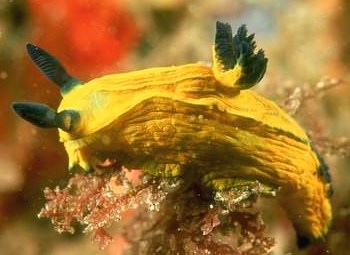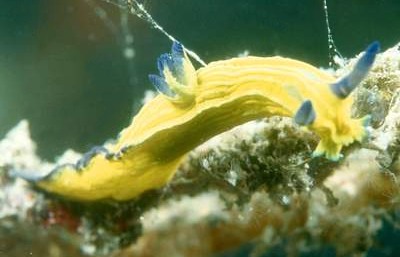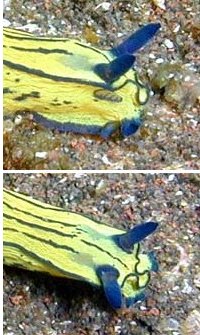

Tambja sp. 6
Order: NUDIBRANCHIA
Suborder: DORIDINA
Superfamily: ANADORIDOIDEA
Family: Polyceridae
Subfamily: Nembrothinae
PHOTO
UPPER: Mun islet, Seogwipo, CheJu island., Sth Korea. 15m depth., Apr. 2001.
LOWER: Mun islet. Che Ju island. Sth Korea.
9 m depth. May.2001
Photos: Dong Bum, Koh
See message discussing this species relationships to Tambja amakusana.
Authorship detailsRudman, W.B., 2002 (September 15) Tambja sp. 6 [In] Sea Slug Forum. Australian Museum, Sydney. Available from http://www.seaslugforum.net/find/tambsp6
Related messages
Tambja oliva from the Maldives
November 30, 2009
From: Mónica Alonso

Hello:
We are a couple of amateur naturalists and we found this specimen of (Tambja sp.) during a diving safari in Maldives (North Male Atoll, South Male Attoll, Ari atoll)
Locality: North Male Atoll, South Male Attoll, Ari Atoll, 10 m, Maldives, Indic, 02 May 2008. Length: 10 - 15 mm. Photographer: Monica Alonso & Luis Abad.
Monica Alonso & Luis Abad
monicaalonso091170@hotmail.com
Alonso, M. & Abad, L., 2009 (Nov 30) Tambja oliva from the Maldives. [Message in] Sea Slug Forum. Australian Museum, Sydney. Available from http://www.seaslugforum.net/find/22840Dear Mónica,
This is an interesting puzzle. I am pretty sure it is the species I am calling Tambja sp. 6. It doesn't have a name and apart from its characteristic colour it has distinctly large oral tentacles more in keeping with the genus Roboastra. There are a few other species, such as T. tentaculata with similar oral tentacles.
Best wishes,
Bill Rudman
Tambja amakusana? from Singapore
August 14, 2006
From: Stacy Thio


Hi Bill,
This type of nudibranch has been spotted in Singapore waters several times. My guess is Tambja oliva?. Hope you can help us id this chap. Thanks a lot.
Locality: Pulau Hantu, about 9m, Singapore, Hantu waters, 19 Feb 2006. Length: 10-20mm. Photographer: Stacy Thio.
Cheers,
Thio
staad3@yahoo.com
Thio, S., 2006 (Aug 14) Tambja amakusana? from Singapore. [Message in] Sea Slug Forum. Australian Museum, Sydney. Available from http://www.seaslugforum.net/find/17360
Dear Stacy,
This is another piece in the Tambja amakusana puzzle. Have a look at my comments about this species in an earlier message [#3545]. Your photo matches what I am calling Tambja sp. 6. but I think we have to consider whether that species, Tambja sp 9, Tambja sp.10 and Tambja cf. amakusana are all colour forms of one species which I guess would be T. amakusana.
Best wishes,
Bill Rudman
Tambja sp. 6? from Japan
September 19, 2002
From: Tomohiko Kurihara

Dear Bill.
Here are photos of an unknown opisthobranch. I found it at Osezaki, Suruga-bay, Japan. I found it on Bugula neritina in the daytime and when night comes,it was crawling on rock. I have ever seen this before. Is it a species of Tambja?
Osezaki, Suruga-bay, Izu-peninsula, Japan. 14 April 2002. Length: about 30mm
Sincerely,
Tomohiko Kurihara
miyamoto@info.email.ne.jo


Dear Tomohiko,
This is an interesting find. From your mention of it on the bryozoan Bugula I am pretty sure it is a species of Tambja. I think it is the same as the species reported today by Dong Bum from Korea. It differs in having blue ridges on the mantle and blue spots on the sides of the body, but if you look at the Korean photos you can see the ridges on the mantle.
Best wishes,
Bill Rudman
Tambja from Korea
September 19, 2002
From: Dong Bum, Koh


Dear Bill,
Here are some photos of another Tambja sp. I have regarded it as Tambja amakusana. Could you give me some information about that?
UPPER: Mun islet, Seogwipo, CheJu island., Sth Korea. 15m depth., Apr. 2001.
LOWER: Mun islet. Che Ju island. Sth Korea.
9 m depth. May.2001
Photos: Dong Bum,Koh
Your Forum is very useful to me.
Best wishes,
Dong Bum, Koh
drkoh@seasee.co.kr
Koh, D.B., 2002 (Sep 19) Tambja from Korea. [Message in] Sea Slug Forum. Australian Museum, Sydney. Available from http://www.seaslugforum.net/find/7535Dear Dong Bum,
I haven't got any photos of typical Tambja amakusana to compare your animals with. Tambja cf. amakusana is possibly a colour form of T. amakusana but I think more animals need to be looked at to be sure. A number of these green species seem to have a yellow colour form but T. amakusana seems to have blue-tipped rhinophores, gills and tail while in your animal the blue seems to be much more extensive, including a blue median ridge from the posterior tip of the tail forward to join the posterior edge of the mantle edge. Until we know more I think it is best to call your animal Tambja sp. 6.
Best wishes,
Bill Rudman
